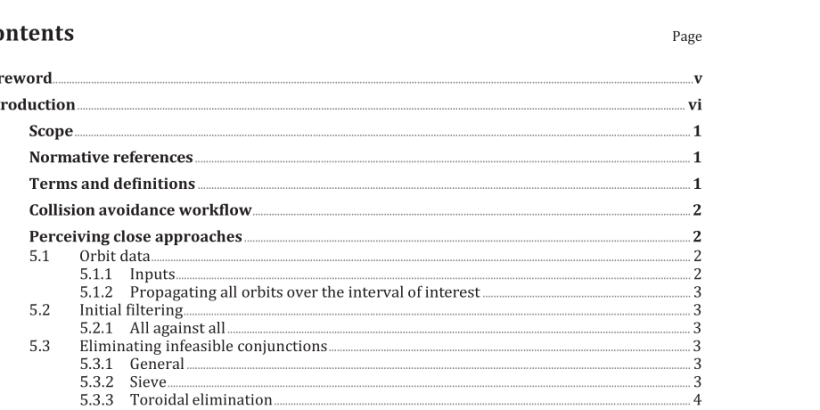ISO/TR 16158:2021 pdf download – Space systems — Avoiding collisions among orbiting objects.
4 Collision avoidance workflow The avoidance process begins with orbit data, the content of which is specified in ISO 26900. The data can be provided by collaborating satellite operators and from observers who are capable of viewing satellites. It is also important to know the nature of each object if possible. This information includes size, mass, geometry, and the operational state (e.g. active or inactive). Finally, collision probability estimates consider the inevitable imprecision associated with orbit determination and other hypotheses and measurements. Figure 1 depicts this top-level workflow.
5 Perceiving close approaches 5.1 Orbit data 5.1.1 Inputs Inputs to conjunction assessment are principally data that specify the trajectories of the objects of interest. These are one of three types of information: orbital elements, ephemerides, or observations of satellites. Orbital elements in this context include parameters that describe the evolution of the trajectory and which can be used to estimate the trajectory in the future. They are derived from past observations of satellites. Ephemerides are time-ordered sets of position and velocity within which one interpolates to estimate the position and velocity at intermediate times. Ephemerides need to span the future time interval of interest, where the equations of motion having been propagated by the provider. Observations are measurements of satellite position and velocity from one or more well-characterized and registered instruments. The recipient can use those observations to estimate the evolution of the trajectory either through direct numerical integration of governing equations or by developing orbital elements for subsequent propagation. ISO/TR 11233 describes the way a provider’s orbit determination scheme is codified. There are normative formats for orbital elements and ephemerides (see ISO 26900). See CCSDS 503.0-B-2 for normative formats for transmitting observations.
5.1.2 Propagating all orbits over the interval of interest All orbits being under consideration are best forecasted by the model in which they were created. Since orbit determination and propagation are uncertain, the propagation scheme can be well suited for this interval. ANSI/AIAA S-131-2010 is a normative reference for orbit propagation. Osculating orbit estimates grow imprecise over time intervals long compared to the time span of underlying observations. This imprecision is sufficient to make collision probabilities misleading. Therefore, conjunction assessment in low Earth orbit is unreliable at the present state of the art for periods longer than approximately one week beyond the latest orbit determination, depending on the orbit of interest. Some particularly stable orbits can be estimated reliably for longer periods. Probability of collision can be estimated over long periods using consistent statistical descriptions of satellite orbits and the evolution of the debris environment. These techniques estimate whether a conjunction will occur or not but cannot expose which specific objects can be involved.
5.2 Initial filtering 5.2.1 All against all The most complete process would examine each object in orbit against all others over the designated time span. Most techniques eliminate A-B duplication, defined as screening B against A in addition to A against B. Therefore, the number of screenings necessary is not the factorial of the number of satellites. It is impossible to know how many objects orbit the Earth. Many escape perception. The best a satellite operator can do is to consider those that have been detected. One cannot screen against unknown objects that one estimates can be present. 5.3 Eliminating infeasible conjunctions 5.3.1 General Much of the population in orbit physically cannot encounter many other satellites during the period of interest. For example, even if uncontrolled, geostationary satellites 180 degrees apart in longitude are not threats to each other. 5.3.2 Sieve Sieve techniques employ straightforward geometric and kinematic processes to narrow the spectrum of feasible conjunctions based on the minimum separation between orbits. They are based variously on orbit geometry, numerical relative distance functions, and actual orbit propagation.
